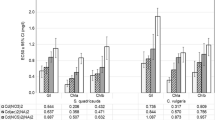Abstract
Scenedesmus obliquus was incubated with Cd2+ in the presence or absence of calcium at low (10°C) or high (40°C) temperature. The Cd2+ uptake was affected not only by Ca2+ but also by temperature. Growth rate was inhibited by Cd2+ especially at low temperature. In all Ca2+-containing cultures,S. obliquus exhibited higher rates of growth, dry matter and pigment fractions than in those containing Cd2+ alone. Proteins exhibited a similar response. Ca2+ in the presence of Cd2+ was most efficient where protein contents were mostly doubled. On the other hand Ca2+ reduced the solute leakage by the test alga at 10 and 40°C.
Similar content being viewed by others
References
Abdel-Basset R., Issa A.A.: Membrane stabilization and survival of dehydratedChlorella fusca cells induced by calcium.Biologia Plant.36, 389–395 (1994).
Abdel-Basset R., Issa A.A., Adam M.S.: Chlorophyllase activity: effects of heavy metals and calcium.Photosynthetica31, 421–425 (1995).
Adam M.S., Abdel-Basset R.: Effect of lead nitrate and lead acetate on the growth and some metabolic processes ofScenedesmus obliquus.Acta Hydrobiol.32, 93–99 (1990).
Andreev I.M., Kov V.K., Molotkovsky Y.G.: Calmodulin stimulation of Ca2+/nH+ antiport across the vacuolar membrane of sugar beet taproot.J. Plant Physiol.136, 3–7 (1990).
Babich H., Stotzky G.: Effects of cadmium on the biota: influence of environmental factors.Adv. Appl. Microbiol.23, 55 (1978).
Babich H., Stotzky G.: Heavy metal toxicity to microbe-mediated ecologic processes: a review and potential application to regulatory policies.Environ. Res.36, 111 (1985).
Cain J.R., Paschal D.C., Hayden C.M.: Toxicity and bioaccumulation of cadmium in the colonial green algaScenedesmus obliquus.Arch. Environ. Contam. Toxicol.9, 9 (1980).
Cheung W.Y.: Calmodulin plays a pivotal role in cellular regulation.Science207, 19–27 (1980).
Chu S.P.: The influence of mineral composition of the medium on the growth of planktonic algae. I. Methods and cultural media.J. Ecol.30, 284–325 (1942).
Gadd G.M., Griffith A.J.: Microorganisms and heavy metal toxicity.Microb. Ecol.4, 303–317 (1978).
Greger M., Bertell G.: Effects of Ca2+ and Cd2+ on the carbohydrate metabolism in sugar beet (Beta vulgaris).J. Exp. Bot.247, 167–173 (1992).
Grill E., Winnacker E.L., Zenk M.H.: Phytochelatins: the principal heavy-metal complexing peptides of higher plants.Science230, 674–676 (1985).
Healey F.P.: Interacting effects of light and nutrient limitation on the growth rate ofSynchococcus linearis (Cyanophyceae).J. Phycol.21, 134–146 (1985).
Issa A.A., Abdel-Basset R., Adam M.S.: Abolition of heavy metal toxicity onKirchneriella lunaris (Chlorophyta) by calcium.Ann. Bot.75, 189–192 (1995).
Leopold A.C., Musgrave M.E., Williams K.M.: Solute leakage resulting from leaf desiccation.Plant Physiol.68, 1222–1225 (1981).
Leopold A.C., Willing R.P.: Evidence for toxicity effects of salt on membranes, pp. 67–91 in R.C. Staples, G.H. Toennissen (Eds):Salinity Tolerance in Plants, Strategies for Crop Improvement. J. Wiley & Sons, New York 1984.
Lindberg S., Wingstrand G.: Mechanism for Cd2+ inhibition of (K++Mg2+) ATPase activity and K+ (86Rb+) uptake in roots of sugar beet (Beta vulgaris).Physiol. Plant63, 181–186 (1985).
Marker A.F.H., Crowther C.A., Gunn R.J.M.: Methanol and acetone as solvents for estimating chlorophylla and phaeopigments by spectrophotometry.Arch. Hydrobiol., Beiheft, Ergebnisse der Limnologie14, 52–69 (1980).
Metzner H., Rau H., Senger H.: Untersuchungen von Synchronisierbarkeit einzelner Pigmentmangel-Mutant vonChlorella.Planta65, 186–194 (1965).
Nakamura Y., Tanaka K., Ohta E., Eskata M.: Protective effect of external Ca2+ on elongation and the intracellular concentration of K+ in intact mung bean roots under high NaCl stress.Plant Cell Physiol.31, 815–821 (1990).
Peterson P.J.: Adaptation to toxic metals, pp. 51–69 in,Metals and Micronutrients Uptake and Utilization by Plants (D.A. Robb, W.S. Pierpoint, Eds). Academic Press, London 1983.
Poovalah B.W., Leopold A.C.: Deferral of leaf senescence with calcium.Plant Physiol.52, 236–239 (1973).
Rai L.C., Raizada M.: Effect of nickel and silver ions on survival, growth, carbon fixation and nitrogenase activity inNostoc muscorum: regulation of toxicity by EDTA and calcium.J. Gen. Appl. Microbiol.31, 329–337 (1985).
Rai L.C., Haur J.P., Kumar H.D.: Phycology and heavy-metal pollution.Biol. Rev.56, 99 (1981).
Raven J.A., Geider R.J.: Temperature and algal growth.New Phytol.110, 441–461 (1988).
Rosko J.J., Rachlin J.W.: The effect of cadmium, copper, mercury, zinc and lead on the cell division, growth, chlorophyll content of the chlorophyteChlorella vulgaris.Bull. Torrey Bot. Club1104, 226 (1977).
Sabnis D.D., Gordon M., Galston A.E.: A site with an affinity for heavy metals on the thylakoid membranes of chloroplasts.Plant Physiol.44, 1355–1363 (1969).
Sorentino C. The effects of heavy metals on phytoplankton: a review.Phykos,18, 149 (1979).
Sorokin C., Krauss R.W.: Effects of temperature and illuminance onChlorella growth uncoupled from cell division.Plant Physiol.37, 37 (1962).
Tomsett A.B., Thurman D.A.: Molecular biology of metal tolerances of plants.Plant Cell Environ.11, 383–394 (1988).
Trevors J.T., Stration G.W., Gadd G.M.: Cadmium transport, resistance and toxicity in bacteria, algae and fungi.Can. J. Microbiol.32, 247 (1986).
Trivedi S., Erdel L.: Effects of cadmium and lead on the accumulation of Ca2+ and K+ and on the influx and translocation of K+ in wheat of low and high K+ status.Physiol. Plant84, 94–100 (1992).
Truhaut R., Ferard J.F., Jouany J.M.: Cadmium, IC50 determination onChlorella vulgaris involving different parameters.Ecotoxicol. Environ. Saf.4, 215 (1980).
Vymazal J.: Toxicity and accumulation of cadmium with respect to algae and cyanobacteria: a review.Toxic. Assess.2, 387 (1988).
Author information
Authors and Affiliations
Rights and permissions
About this article
Cite this article
Issa, A.A., Adam, M.S. & Abdel-Basset, R. Effect of Ca2+ on the detoxification of Cd2+ byScenedesmus obliquus cells at low or high temperature. Folia Microbiol 43, 645–648 (1998). https://doi.org/10.1007/BF02816383
Received:
Revised:
Issue Date:
DOI: https://doi.org/10.1007/BF02816383




